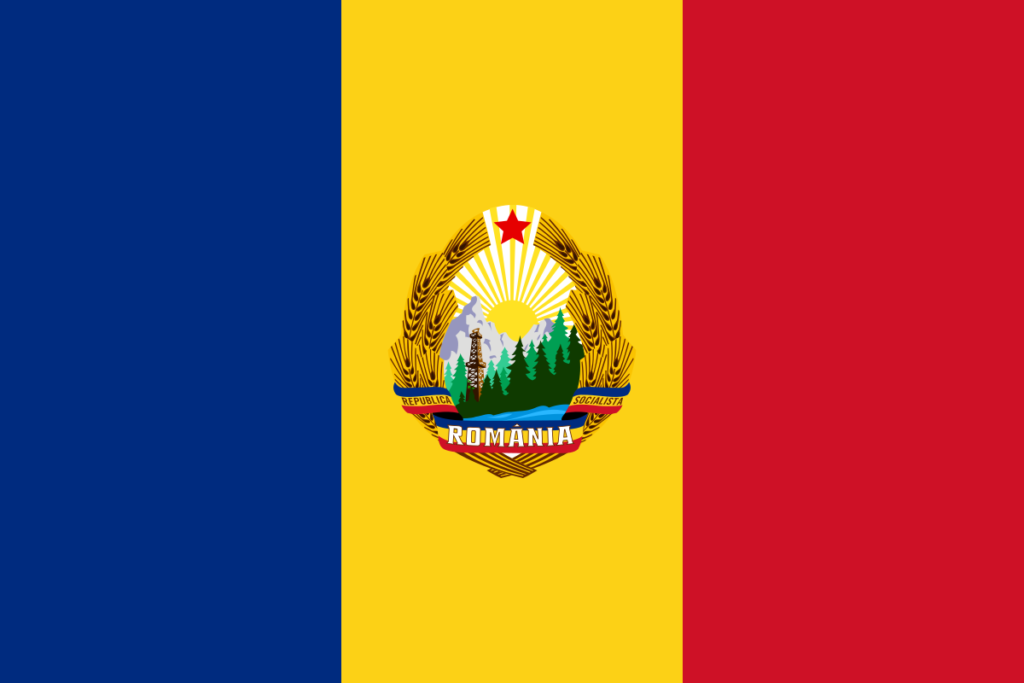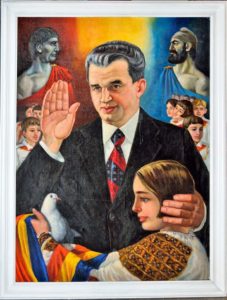 The modern history of Romania is far from cheerful. Despite fighting alongside the Fascist forces during WW2, in the early post-war years, Romania was occupied by Soviet troops. In 1947 King Michael was forced to abdicate the throne and the People’s Republic of Romania was declared. This paved the way for Romania to become a hardline Communist state for the next 42 years. Towards the end of Communist rule, it was en route to becoming a North Korean style country.
The modern history of Romania is far from cheerful. Despite fighting alongside the Fascist forces during WW2, in the early post-war years, Romania was occupied by Soviet troops. In 1947 King Michael was forced to abdicate the throne and the People’s Republic of Romania was declared. This paved the way for Romania to become a hardline Communist state for the next 42 years. Towards the end of Communist rule, it was en route to becoming a North Korean style country.
In the early years, the Romanian Communist Party steadily became more dominant until Red Army soldiers withdrew in 1958. Whilst not a part of the Soviet Union, the Socialist Republic of Romania was Soviet-aligned but reserved the dominant place in its constitution for the Communist Party of Romania.
In 1965, the ruler of the Communist party, Gheorghe Gheorghiu-Dej, died and a man born in a peasant farm in rural Romania began his rise to the top of the Romanian Communist Party. His name was Nicolae Ceaușescu and after seizing the presidency in 1974, he would rule Communist Romania for 15 years with his loyal but dominating wife by his side. Hand in hand, they would both watch the country and their lives go down in flames.
Life in Communist Romania:
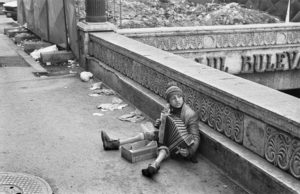 Life in the country varied massively between different periods, the early Soviet-occupied period was blood-spattered with the Soviet authorities rounding up anybody deemed to be an enemy of the state and sending them to forced labor or execution, and in a country recently allied with the Fascists, this was a large number of people.
Life in the country varied massively between different periods, the early Soviet-occupied period was blood-spattered with the Soviet authorities rounding up anybody deemed to be an enemy of the state and sending them to forced labor or execution, and in a country recently allied with the Fascists, this was a large number of people.
As the Communist party under Gheorghe Gheorghiu-Dej became entrenched they began to initiate agricultural collectivization and target the pre-war elite, confiscating property, executing people and sending them for forced labor in newly opened gulags across the country. Tens of thousands of Romanians were killed in the early years of Communism in Romania.
Life slightly improved under the early years of Ceaucescu and he enjoyed a wave of popularity when he eased the censorship on press and condemned the 1968 Soviet invasion of Czechoslovakia. He was even received by Queen Elizabeth and visited by US and French presidents hoping for an anti-Soviet friend in the Eastern Bloc. However, this was short-lived and the Communist regime in Romania under Ceausescu rapidly turned into one of the most repressive Communist regimes in the Eastern Bloc with a wave of human rights abuses, press censorship, and repression.
Economic mismanagement during the 1970’s placed enormous debts on Romania and in response, the regime began exporting the countries industrial and agricultural production in a desperate attempt to pay them leading to shortages that caused a miserable quality of life in the country: food, water, heating, electricity, and medicine were all heavily rationed. Meanwhile, Ceausescu was holding enormous mass games influenced by North Korea and building grand palaces bigger than the Pentagon. At this point, foreign relations began to collapse.
The dark history of Communist Romania
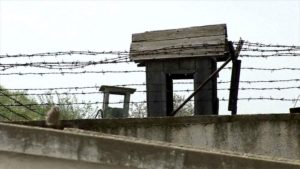 There were a number of dark incidents during the early days of the Communist regime, the first being the initially failed Danube Canal project. The aim of the project was to shorten the distance to the Black Sea and avoid the Danube delta. In the late 1940s, Gulags began to appear all along the route of the canal and hundreds of thousands of prisoners were forced into them.
There were a number of dark incidents during the early days of the Communist regime, the first being the initially failed Danube Canal project. The aim of the project was to shorten the distance to the Black Sea and avoid the Danube delta. In the late 1940s, Gulags began to appear all along the route of the canal and hundreds of thousands of prisoners were forced into them.
Detainees were under the authority of brigades of criminals, much like the Kapo system in Nazi concentration camps, and these criminals were permitted to use extreme violence against the slave laborers. Prisoner’s food was insufficient and many resorted to eating rats and grass to survive. The canal was labeled by the Communist Party as the “graveyard of the Romanian bourgeoisie” with the most significant goal being the complete physical elimination of undesirable social classes.
Another infamous incident was the Pitesti experiment, a Communist re-education experiment known as the largest and most intensive brainwashing torture program in the Eastern Bloc. Up to 5,000 people, mostly young people and students were brought to the prison and forced to undergo brutal, inhuman treatment to discard any human traits they formerly held to the point that they would be completely obedient to Communism, in essence, a ‘’psychologically pure, ultra Communist’’.
The experiment began with beatings, forced blasphemy, and torture but descended into prisoners being submerged in raw sewage and sheer humiliation. It is reported that many prisoners resembled lepers before death. When it was discovered how bad the experiment had become, some of the people who oversaw the operation were put on trial and were shot.
The Secret Police of Communist Romania
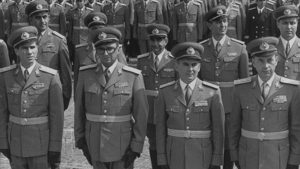 Whilst the USSR had the KGB, Romania had the Securitate (Department of State Security) which was known as one of the largest and most brutal police forces in the world at the time. The infamous Soviet NKVD assisted in its founding in 1948. Despite Romania at the time only having a population of 22 million, at the height of its power the secret police employed 11,000 highly trained agents and around 500,000 loyal informers. Under Nicolae Ceaușescu, they would carry out the arrests, torture, and deaths of thousands of Romanians. When the Communist regime ended in 1989, the Securitate continued to run until 1991 until they were reorganized.
Whilst the USSR had the KGB, Romania had the Securitate (Department of State Security) which was known as one of the largest and most brutal police forces in the world at the time. The infamous Soviet NKVD assisted in its founding in 1948. Despite Romania at the time only having a population of 22 million, at the height of its power the secret police employed 11,000 highly trained agents and around 500,000 loyal informers. Under Nicolae Ceaușescu, they would carry out the arrests, torture, and deaths of thousands of Romanians. When the Communist regime ended in 1989, the Securitate continued to run until 1991 until they were reorganized.
How did Communist Romania collapse?
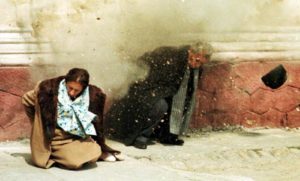 As the poor quality of life under Ceausescu continued to plummet rapidly in the 1980s, Romanian anger was boiling. A revolution sprang up in the city of Timisoara and was violently put down with the death of 19 people. This caused outrage across the capital and sparked what is now known as the Romanian revolution. when Ceausescu gave a speech on palace square, the crowd gradually turned on him before descending into a full-blown riot between civilians and the Communist Romanian army.
As the poor quality of life under Ceausescu continued to plummet rapidly in the 1980s, Romanian anger was boiling. A revolution sprang up in the city of Timisoara and was violently put down with the death of 19 people. This caused outrage across the capital and sparked what is now known as the Romanian revolution. when Ceausescu gave a speech on palace square, the crowd gradually turned on him before descending into a full-blown riot between civilians and the Communist Romanian army.
The army gradually began to take the side of the protesters. Nicolae and his wife Elena fled their palace by helicopter and landed in Targoviste just outside of Bucharest. It was here that they were captured and placed on trial for 1 hour and 15 minutes. The Ceausescu execution quickly followed as they were dragged outside killed in a hail of Kalashnikov fire. On December 25th, 1989, Nicolae Ceausescu shot. He was the only Communist dictator in the Eastern Bloc to be executed by his own people.
Romania rapidly descended into anarchy during a power struggle and many of those who later took power were former Communists. Romania today remains one of the most corrupt countries in the European Union.
Flag of Communist Romania:
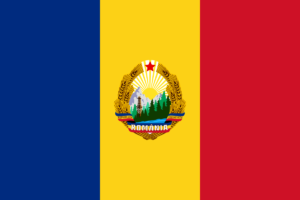 The flag of the Socialist Republic of Romania consists of a blue, yellow, and red vertical tricolor with a central emblem that consisted of wheat and the hammer and sickle. During the Romanian revolution, anti-Communist revolutionaries would often cut out the emblem from the flag.
The flag of the Socialist Republic of Romania consists of a blue, yellow, and red vertical tricolor with a central emblem that consisted of wheat and the hammer and sickle. During the Romanian revolution, anti-Communist revolutionaries would often cut out the emblem from the flag.
To visit Romania with us, check out one of our many Chernobyl & Transnistrian tours which start or finish in Bucharest and include a tour of all the Ceausescu and Communist related sights in the city.

